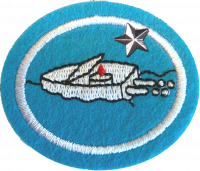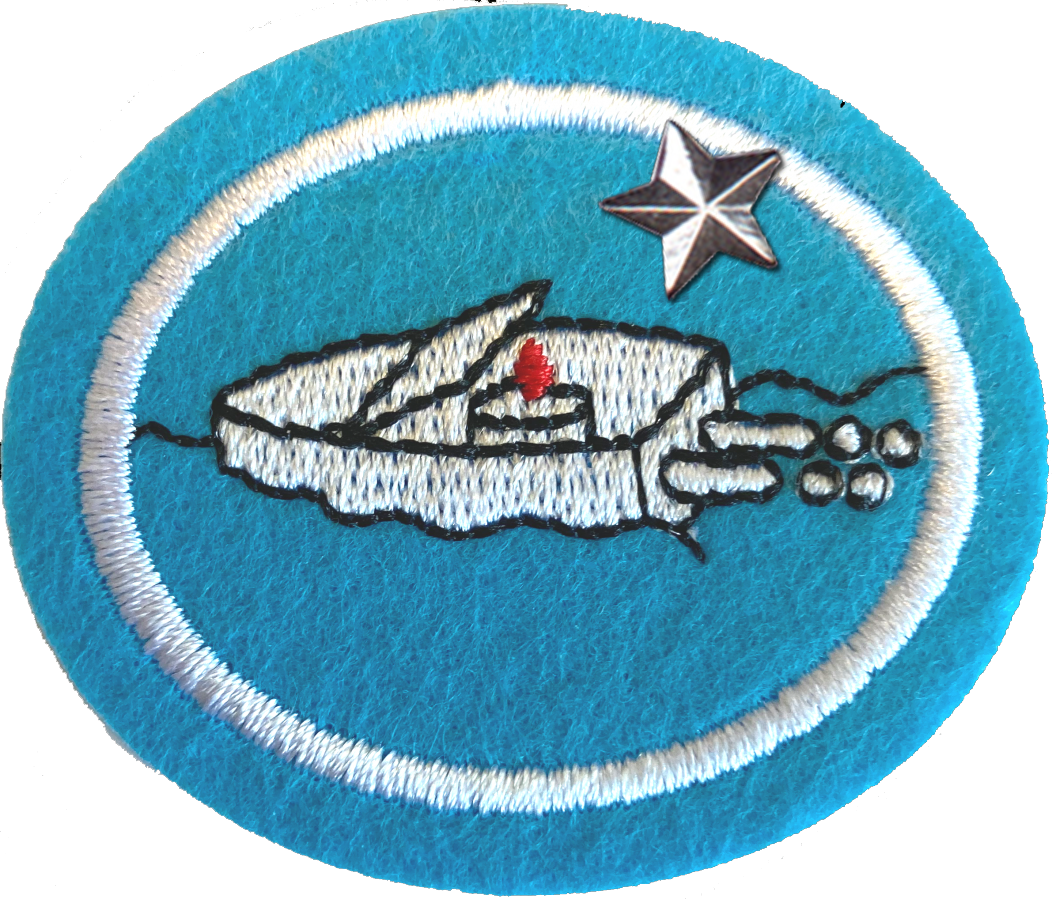Difference between revisions of "AY Honors/Toy Boat Regatta - Advanced/Answer Key/es"
From Pathfinder Wiki
< AY Honors | Toy Boat Regatta - AdvancedAY Honors/Toy Boat Regatta - Advanced/Answer Key/es
(Created page with "{{clear}}") |
(Updating to match new version of source page) |
||
| (13 intermediate revisions by one other user not shown) | |||
| Line 1: | Line 1: | ||
| − | + | {{HonorSubpage}} | |
| − | |||
| − | |||
| − | {{ | ||
| − | |||
| − | |||
| − | |||
| − | |||
| − | |||
| − | |||
| − | |||
| − | }} | ||
| − | |||
| − | |||
| − | |||
<section begin="Body" /> | <section begin="Body" /> | ||
{{ansreq|page={{#titleparts:{{PAGENAME}}|2|1}}|num=1}} | {{ansreq|page={{#titleparts:{{PAGENAME}}|2|1}}|num=1}} | ||
<noinclude></noinclude> | <noinclude></noinclude> | ||
| − | <!-- 1. | + | <!-- 1. Tener la especialidad de Regata de botes de juguete. --> |
| − | {{honor_prerequisite| | + | {{honor_prerequisite|displayname=Regata de botes de juguete|honor=Toy Boat Regatta}} |
<noinclude></noinclude> | <noinclude></noinclude> | ||
| Line 25: | Line 11: | ||
{{ansreq|page={{#titleparts:{{PAGENAME}}|2|1}}|num=2}} | {{ansreq|page={{#titleparts:{{PAGENAME}}|2|1}}|num=2}} | ||
<noinclude></noinclude> | <noinclude></noinclude> | ||
| − | <!-- 2. | + | <!-- 2. Dibujar un esquema de un bote pop pop (también conocido como un bote a vapor casero) que muestre las características pertinentes y cómo funcionan. Mostrar las opciones de un motor de bobina de cobre y un motor de diafragma. --> |
{{clear}} | {{clear}} | ||
| Line 33: | Line 19: | ||
{{ansreq|page={{#titleparts:{{PAGENAME}}|2|1}}|num=3}} | {{ansreq|page={{#titleparts:{{PAGENAME}}|2|1}}|num=3}} | ||
<noinclude></noinclude> | <noinclude></noinclude> | ||
| − | <!-- 3. | + | <!-- 3. Describir qué sucede al agua líquida cuando se convierte en vapor y demostrar este fenómeno usando cualquier experimento de su elección. --> |
{{clear}} | {{clear}} | ||
| Line 41: | Line 27: | ||
{{ansreq|page={{#titleparts:{{PAGENAME}}|2|1}}|num=4}} | {{ansreq|page={{#titleparts:{{PAGENAME}}|2|1}}|num=4}} | ||
<noinclude></noinclude> | <noinclude></noinclude> | ||
| − | <!-- 4. | + | <!-- 4. Describir qué sucede cuando el vapor de agua se enfría y demostrar este fenómeno usando cualquier experimento de su elección. --> |
{{clear}} | {{clear}} | ||
| Line 49: | Line 35: | ||
{{ansreq|page={{#titleparts:{{PAGENAME}}|2|1}}|num=5}} | {{ansreq|page={{#titleparts:{{PAGENAME}}|2|1}}|num=5}} | ||
<noinclude></noinclude> | <noinclude></noinclude> | ||
| − | <!-- 5. | + | <!-- 5. Describir cómo el motor de un bote pop pop utiliza la primera ley de movimiento de Newton. --> |
{{clear}} | {{clear}} | ||
| Line 57: | Line 43: | ||
{{ansreq|page={{#titleparts:{{PAGENAME}}|2|1}}|num=6}} | {{ansreq|page={{#titleparts:{{PAGENAME}}|2|1}}|num=6}} | ||
<noinclude></noinclude> | <noinclude></noinclude> | ||
| − | <!-- 6. | + | <!-- 6. Hacer al menos un bote pop pop usando materiales reciclados alimentados por una vela de té como fuente de calor. --> |
{{clear}} | {{clear}} | ||
| Line 67: | Line 53: | ||
{{ansreq|page={{#titleparts:{{PAGENAME}}|2|1}}|num=7}} | {{ansreq|page={{#titleparts:{{PAGENAME}}|2|1}}|num=7}} | ||
<noinclude></noinclude> | <noinclude></noinclude> | ||
| − | <!-- 7. | + | <!-- 7. Modificar el bote pop pop en el requisito anterior o crear varios botes pop pop para determinar cómo los cambios en la capacidad del depósito y/o el diámetro de los tubos afectan la operación del bote. Hacer una hipótesis de los resultados antes de experimentar en los botes modificados, evaluar el rendimiento y documentar los resultados. --> |
{{clear}} | {{clear}} | ||
| Line 75: | Line 61: | ||
{{ansreq|page={{#titleparts:{{PAGENAME}}|2|1}}|num=8}} | {{ansreq|page={{#titleparts:{{PAGENAME}}|2|1}}|num=8}} | ||
<noinclude></noinclude> | <noinclude></noinclude> | ||
| − | <!-- 8. | + | <!-- 8. Participar en una carrera organizada de botes pop pop usando un bote pop-pop que haya creado para completar esta especialidad. --> |
{{clear}} | {{clear}} | ||
| Line 83: | Line 69: | ||
{{ansreq|page={{#titleparts:{{PAGENAME}}|2|1}}|num=9}} | {{ansreq|page={{#titleparts:{{PAGENAME}}|2|1}}|num=9}} | ||
<noinclude></noinclude> | <noinclude></noinclude> | ||
| − | <!-- 9. | + | <!-- 9. Usar las dimensiones bíblicas del arca de Noé, teorizar de forma independiente cuánto podrían haber pesado los animales y otros cargamentos. Recordar considerar el peso de la madera utilizada en la construcción del arca. Si es posible, comparar sus suposiciones y respuestas con las de otras personas que completan esta especialidad. Basándose en ese peso disponible para la carga, ¿cuántos animales podrían haber cabido en el arca usando sus suposiciones? --> |
| − | + | {{clear}} | |
| − | |||
| − | |||
| − | |||
| − | |||
| − | |||
| − | |||
| − | |||
| − | |||
| − | |||
<noinclude></noinclude> | <noinclude></noinclude> | ||
{{CloseReq}} <!-- 9 --> | {{CloseReq}} <!-- 9 --> | ||
<noinclude></noinclude> | <noinclude></noinclude> | ||
| − | == | + | ==Referencias== |
| − | [[Category:Adventist Youth Honors Answer Book | + | [[Category:Adventist Youth Honors Answer Book/es]] |
<noinclude></noinclude> | <noinclude></noinclude> | ||
| − | + | {{CloseHonorPage}} | |
Latest revision as of 03:00, 13 April 2021
Regata de botes de juguete - Avanzado
Nivel de destreza
2
Año
2021
Version
25.11.2024
Autoridad de aprobación
División Norteamericana
1
Tener la especialidad de Regata de botes de juguete.
2
Dibujar un esquema de un bote pop pop (también conocido como un bote a vapor casero) que muestre las características pertinentes y cómo funcionan. Mostrar las opciones de un motor de bobina de cobre y un motor de diafragma.
3
Describir qué sucede al agua líquida cuando se convierte en vapor y demostrar este fenómeno usando cualquier experimento de su elección.
4
Describir qué sucede cuando el vapor de agua se enfría y demostrar este fenómeno usando cualquier experimento de su elección.
5
Describir cómo el motor de un bote pop pop utiliza la primera ley de movimiento de Newton.
6
Hacer al menos un bote pop pop usando materiales reciclados alimentados por una vela de té como fuente de calor.
7
Modificar el bote pop pop en el requisito anterior o crear varios botes pop pop para determinar cómo los cambios en la capacidad del depósito y/o el diámetro de los tubos afectan la operación del bote. Hacer una hipótesis de los resultados antes de experimentar en los botes modificados, evaluar el rendimiento y documentar los resultados.
8
Participar en una carrera organizada de botes pop pop usando un bote pop-pop que haya creado para completar esta especialidad.
9
Usar las dimensiones bíblicas del arca de Noé, teorizar de forma independiente cuánto podrían haber pesado los animales y otros cargamentos. Recordar considerar el peso de la madera utilizada en la construcción del arca. Si es posible, comparar sus suposiciones y respuestas con las de otras personas que completan esta especialidad. Basándose en ese peso disponible para la carga, ¿cuántos animales podrían haber cabido en el arca usando sus suposiciones?


